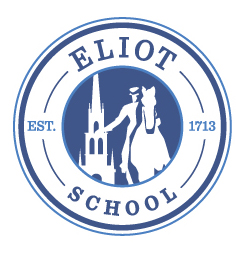History
Situated in Boston’s historic North End, the Eliot K-8 Innovation School is part of the Boston Public Schools system and serves over 800 students across the city’s neighborhoods. Classified in 2012 as an Innovation School, the Eliot is a unique learning environment where educators, administrators, families and the community collaborate to create a culture of high achievement. At the Eliot, diversity is embraced and celebrated, while each individual is nurtured and encouraged to maximize his or her potential.
As Boston’s oldest continuously-run school, the Eliot has a rich past that began with its opening as the North Writing School in 1713. After merging with the North Latin School in 1790, the newly formed entity became the John Eliot School, named after a pastor of the North Church in Boston. Throughout its storied history, the Eliot has weathered changes in both orientation and philosophy. It has educated many famous Bostonians, including American patriots Samuel Adams and Paul Revere. Even the school’s facilities contributed to Boston’s rich past, serving as a meeting place for the women’s suffrage movement in 1917. For more than 300 years, we have been keenly focused on driving our school forward to enrich the lives of students both today and in the future.
In 2007, the Eliot was a low-performing school being considered for closure. However, the hiring of new principal Traci Walker Griffith with her holistic approach—serving children academically, socially, and emotionally—and the help of a committed teaching staff, dedicated student families and an engaged community, ushered in a transformation that has produced today’s Eliot K-8 Innovation School.
The success of the Eliot drove administrators, families, and the community to campaign for its expansion in January 2011. City leaders took notice and acquired a nearby building to add to the school’s assets to facilitate its growth. In the fall of 2012, some of the Eliot’s Middle School classes were moved into the newly-acquired building, which created space for a new Kindergarten class, the first in a new strand of classes to be added each year until its completion with grade eight.
In September of 2012, the expanded Eliot was recognized by Governor Deval Patrick and the Department of Elementary and Secondary Education as a “Commendation School” for the third consecutive year (1). It’s now considered by many to be the best public school in Boston and has a current waiting list larger than its enrollment.
During its turnaround phase, the Eliot made many changes to its instruction and culture to advance the academic proficiency of all of its students. New partnerships were formed and programs created that eliminated some of the hurdles that often make it difficult for schools to help students improve their performance. One such program assists teachers and families in addressing behavioral issues that are barriers to a child’s academic success. Another element differentiating the Eliot’s curriculum is the practice of inclusion, where all levels of learners thrive in the same classroom. These changes along with ongoing evaluation of teaching methods and assessment strategies began to improve academic outcomes for all Eliot students.
In early 2011, the Eliot applied to the school district to change its classification to an innovation school. As an innovation school, the Eliot to implement further changes to its curriculum, staffing, teaching methods and assessment strategies, yet still remain a Boston Public School. The city granted approval for the status change in September 2012, just in time for the school’s expansion into its new second building.
(1) Commendation Schools are schools that have substantially narrowed the proficiency gap for certain student groups, have shown high growth for two consecutive years, and/or have exited NCLB accountability status.
